This is a guest blog post by Monica, a school-based SLP, all about core vocabulary and why it is so important to focus on!
Do you have pre-verbal and non-speaking students, and you’re not quite sure where to start? Core vocabulary is your research-backed answer. In this post, we’ll cover what core vocabulary is, why it’s essential, and how to use it in your therapy sessions. By the end, you’ll have a ton of ideas to support your students!
If you’re an SLP Now member, there’s a preview of our core vocabulary lessons in this post. They plan everything out and have everything you need in 10 minutes or less of planning and prep time a week.
What is Core Vocabulary?
Core vocabulary is a treatment approach where you teach words that are general and frequently used.
The philosophy is that if you had to pick a limited set of words to teach a student, you would want words that allow for different communicative intents and for the words to be used across many different situations and environments (Beukelman et al., 1984).
A study done by Fallon (2001) found that core words made up to 89% of a preschooler’s vocabulary. These words are most commonly “pronouns, verbs, prepositions, and demonstratives”. These core words come from studies that compared the most frequently used words in conversation (Banajee et al., 2009, Beukelman et al., 1984). Fringe words (nouns) are the counterpart to core words and not included core word lists, as they are specific to certain situations.
It’s easiest to think of core words when you pretend you only have a couple of words to communicate. If you wanted someone to cut up your apple, saying “apple” (a fringe word) would not immediately communicate what you wanted. You could gesture cut, but it might not be universally understood. If you said “cut” and handed someone an apple, they would quickly know what you wanted to communicate. You would also use the word “cut” for other things and in different situations. You would not be able to use the word “apple” in other contexts the same way.
Core words are also what get used with an AAC system, both low and high-tech. You see them mostly on the main page. Project Core is a great resource for core boards if you need a place to start. (They also have a lot of free trainings!)
Why is core vocabulary important?
You get early buy-in because these are POWER words that help students to communicate.
You can move beyond requesting to help students voice their needs, make comments, ask questions, interact with others, talk about their feelings, and more.
Access to core vocabulary is a great way to work on oral and written skills to give students access to academic curriculum that specific vocabulary would not (Witkowski & Baker, 2012).
It’s easy to make EBP. There’s a lot of research-based evidence behind core words. You can customize word selection for your students and their families. As a clinician, you can make clinical decisions about which words to select and use best practices during your therapy sessions. (Hint: It’s a lot of modeling.)
Who can benefit from a core vocabulary approach?
You will most commonly use core words with emergent/beginning communicators.
Check out this resource from Project Core if you want to learn more about emergent/beginning communicators. http://www.project-core.com/beginning-communicators-module/
How do I pick which core vocabulary words to use?
Assume competence and that your student will be able to learn core words. Make sure you make a core board for yourself and staff members to model for your students! You don’t have to start with low-tech, but it’s a low-cost and easily accessible way to start using core vocabulary.
Don’t choose words based on what would help them be compliant in the classroom. You won’t get student buy-in, and it won’t help to reduce “behavior”. It will take time and patience, but it’s so worth it! You want a variety of core words to express a variety of communicative intents (not just requesting!) and ease points of frustration for the student (Witkowski & Baker, 2012).
Pick core words to target based on high-frequency use according to research, their setting (Rutherford et al., 2020), and what’s important to the student and their family.
The Banajee et al., (2009) article is linked here for reference.
Here’s a great post from Praactical AAC that links to questionnaires to send out to team members when thinking about vocabulary selection. Most words will be core words, but important fringe words should also be included. https://praacticalaac.org/praactical/praactical-resources-vocabulary-selection-questionnaire/
How do I use core vocabulary in my therapy sessions?
Use core boards to model and for your student to communicate with. Honor all communication (unaided and aided), and don’t expect language output (pointing to the word on the core board). Like natural development, it takes many exposures before a child uses new words (Crowe et al., 2021).
It’s going to take time! Model and give opportunities for language. Point to the words you are saying on the core board as you are saying them. You might have to adjust your sentences to use the core words that are available. Use activities that will allow you to model the core word as many times as possible and allow for opportunities for your student to use that core word (Crowe et al., 2021).
As you model, you are not modeling what you want to hear from the student but the possibility of what language the student could have. It’s very age-appropriate to have silly answers and communicate refusal, so don’t forget to model that in your sessions! Even though you’re modeling a core word, the focus is on language input and increasing different types of communicative intents (model and plan for requesting, commenting, asking questions, etc.).
Here’s some more information on what it is and free training also from Project Core on modeling! http://www.project-core.com/aided-language-input-module/
Research shows that you need at least 30 models in a session (Binger and Light, 2007). Stay with me for a lesson plan included with the SLP Now membership that hits 30+ repetitions in one session in less than 10 minutes of prep and planning a week.
What it look like to use core vocabulary in a session?
Here’s an example of a routine that’s worked well for me with students, mostly preschool to kindergarten, that required different levels of support. For the most part, I follow this routine, but we all know that there are days when we need to mix it up! I am not a huge stickler with the order of the activities, especially if I am going to get more participation by letting my students choose what goes first. Modeling language takes a higher priority for me in my sessions.
I like to include something with music or a video so we can act out the core word. Adding movement to the mix is always a win!
A book activity comes next. (Check out this podcast on the importance of AAC and literacy! https://slpnow.com/042-a-crash-course-in-aac-literacy/).
Last is a play activity that is an opportunity for using the core word that’s less structured. I do a mix of therapist-led and child-led activities.
Here’s a preview of what’s included in the membership that follows this routine!
A video is included for each core word. Each video has everyday activities that use the target core word. The bar on the bottom of the view will let you know when each scene is done so that you can pause and act it out!
This is a screenshot from the video for the word “go”.
The book for “go” is We’re Going on a Leaf Hunt. There are activities to go with a book for each core word, with lots of opportunities to work on other goal areas!


The play activity for “go” is a virtual trip to the zoo! Students can “go” see different animals and talk about their trip along the way!

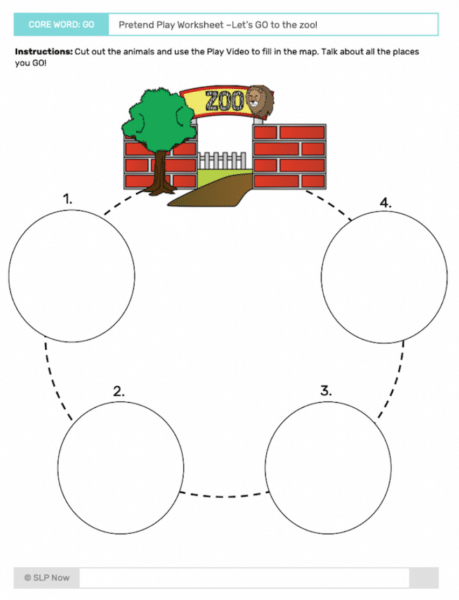
The companion packets also include parent newsletters, ideas for targeting different goals, tips for training staff members, and more! The materials are perfect for push-in classroom lessons and also as small group activities. They are super adaptable!
Last-Minute Tips!
Be flexible. Being a school SLP is always a juggling act! Can you push into free play in the preschool setting and model while you play?
Include focused interests, and be able to pivot.
The companion packets give ideas for including focused interests. I always found that it was easier to incorporate favored items and increased participation.
The membership also has additional core vocabulary activities, including more literacy activities and interactive books.
I adapt these activities to use for other groups that are not using core vocabulary. That means less planning for me! The videos are great for describing and making sentences, and the book gets used for other literacy-based activities.
References
Banajee, M., Dicarlo, C., & STRICKLIN, S. (2009). Core Vocabulary Determination for Toddlers. AAC: Augmentative and Alternative Communication, 19, 67–73. https://doi.org/10.1080/0743461031000112034
Beukelman, D. R., Yorkston, K. M., Poblete, M., & Naranjo, C. (1984). Frequency of word occurrence in communication samples produced by adult communication aid users. The Journal of Speech and Hearing Disorders, 49(4), 360–367. https://doi.org/10.1044/jshd.4904.360
Binger, C., & Light, J. (2007). The effect of aided AAC modeling on the expression of multi-symbol messages by preschoolers who use AAC. Augmentative and Alternative Communication (Baltimore, Md. : 1985), 23, 30–43. https://doi.org/10.1080/07434610600807470
Crowe, B., Machalicek, W., Wei, Q., Drew, C., & Ganz, J. (2021). Augmentative and Alternative Communication for Children with Intellectual and Developmental Disability: A Mega-Review of the Literature. Journal of Developmental and Physical Disabilities. https://doi.org/10.1007/s10882-021-09790-0
Fallon, K. A., Light, J. C., & Paige, T. K. (2001). Enhancing Vocabulary Selection for Preschoolers Who Require Augmentative and Alternative Communication (AAC). American Journal of Speech-Language Pathology, 10(1), 81–94. https://doi.org/10.1044/1058-0360(2001/010)
Marvin, C. A., Beukelman, D. R., & Bilyeu, D. (1994). Vocabulary-Use Patterns in Preschool Children: Effects of Context and Time Sampling. Augmentative and Alternative Communication, 10(4), 224–236. https://doi.org/10.1080/07434619412331276930
Rutherford, M., Baxter, J., Grayson, Z., Johnston, L., & O’Hare, A. (2020). Visual supports at home and in the community for individuals with autism spectrum disorders: A scoping review. Autism, 24(2), 447–469. https://doi.org/10.1177/1362361319871756
Witkowski, D., & Baker, B. (2012). Addressing the Content Vocabulary With Core: Theory and Practice for Nonliterate or Emerging Literate Students. Perspectives on Augmentative and Alternative Communication, 21(3), 74–81. https://doi.org/10.1044/aac21.3.74

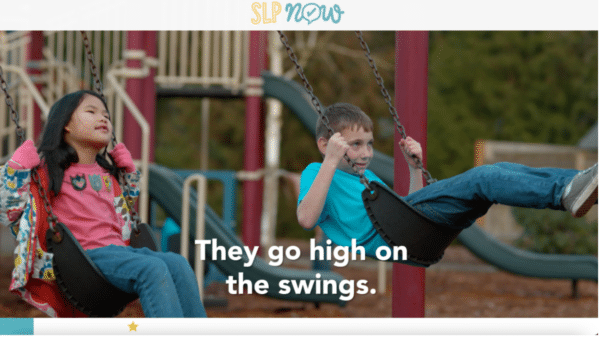

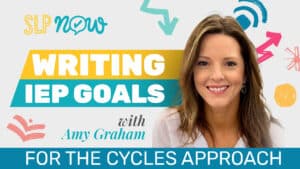
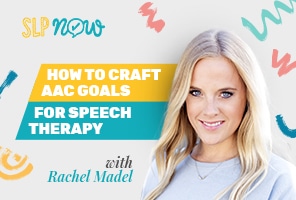
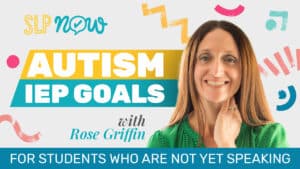
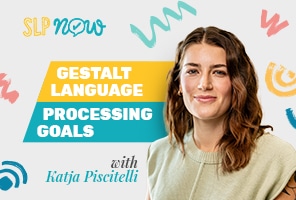
Leave a Reply